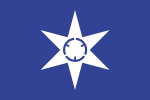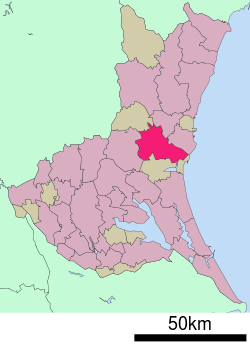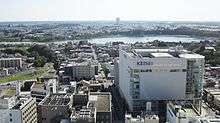Mito, Ibaraki
Mito (水戸市, Mito-shi) is the capital city of Ibaraki Prefecture, in the northern Kantō region of Japan. As of September 2015, the city has an estimated population of 270,953, and a population density of 1,250 persons per km2. Its total area is 217.32 km2.
Mito 水戸市 | |
|---|---|
 City skyline over ume of Kairaku-en | |
 Flag  Seal | |
 Location of Mito in Ibaraki Prefecture | |
 Mito | |
| Coordinates: 36°21′57″N 140°28′16.5″E | |
| Country | Japan |
| Region | Kantō |
| Prefecture | Ibaraki Prefecture |
| Area | |
| • Total | 217.32 km2 (83.91 sq mi) |
| Population (September 2015) | |
| • Total | 270,953 |
| • Density | 1,250/km2 (3,200/sq mi) |
| Time zone | UTC+9 (Japan Standard Time) |
| - Tree | Prunus mume |
| - Flower | Bush clover (hagi) |
| - Bird | White wagtail |
| Phone number | 029-224-1111 |
| Address | 1-4-1 Chūō, Mito-shi, Ibaraki-ken 310−8610 |
| Website | http://www.city.mito.lg.jp/ |

History
The Yamato people settled in Mito around the 4th century CE. Around the end of the Heian period, Baba Sukemoto, a warlord of the Heike clan, moved to Mito and built a castle there. Mito Castle changed hands several times after that; a daimyō named Satake Yoshinobu won it in the mid-16th century, but he was forced to surrender it to Tokugawa Ieyasu in 1603 after the Battle of Sekigahara. Ieyasu's son Tokugawa Yorifusa was then given Mito Castle, becoming head of one of the three "gosanke" branches of the clan qualified to provide a new shōgun should the main family line fail. During this period, Mito was the seat of the so-called Mito School, a congregation of nativist scholars of Confucian persuasion led by Aizawa Seishisai, who during the 18th and 19th centuries advocated Western learning as a means not only to further Japanese technological development and international strength, but as means to prove Japanese uniqueness and superiority among nations. The Kōdōkan was the largest of the han schools. The capital of Edo was directly connected to Mito by the Mito Kaidō.[1] The Tokugawa ruled Mito until the Meiji Restoration.
The modern city of Mito was formed on April 1, 1889 with the establishment of the municipalities system. It was one of the first 31 cities in Japan. With a population of 25,000, it was designated as the prefectural capital. By 1900, the Jōban Line connected Mito to Tokyo, and by 1910, telephones and electric lighting were available throughout the city. More than three-quarters of the city was burned to the ground during the Mito air raid of August 2, 1945, just before the end of World War II.
The borders of Mito expanded in 1955–1958 through the annexation of the neighboring villages of Kamiono, Watari, Yoshida, Sakedo, Kawawada, Yanagawa, Kunita and Iitomi and Akatsuka. The village of Tsunezumi was annexed in 1992. In 2001, Mito was designated a special city with increased local autonomy. The neighboring town of Uchihara was annexed in 2005. The city suffered from severe damage in the 2011 Tōhoku earthquake and tsunami with 25,982 houses completely or partially destroyed; however, there were only two fatalities.
Geography
Mito is located in central Ibaraki Prefecture. Mito Station is about 10 km inland from the Pacific Ocean which Naka River, flowing from the north to the east of the city, pours into. Immediately south is Lake Senba, a recreational area. A main street extends from Mito Station to the west, and residential areas to the south and the west in particular.
Climate
Mito has a humid subtropical climate (Köppen climate classification Cfa) with hot summers and cool winters. Precipitation is significant throughout the year, but the winter months are somewhat drier.
| Climate data for Mito, Ibaraki | |||||||||||||
|---|---|---|---|---|---|---|---|---|---|---|---|---|---|
| Month | Jan | Feb | Mar | Apr | May | Jun | Jul | Aug | Sep | Oct | Nov | Dec | Year |
| Average high °C (°F) | 8.8 (47.8) |
8.9 (48.0) |
11.7 (53.1) |
17.1 (62.8) |
21.3 (70.3) |
23.7 (74.7) |
27.3 (81.1) |
29.6 (85.3) |
25.4 (77.7) |
20.3 (68.5) |
15.9 (60.6) |
11.3 (52.3) |
18.4 (65.2) |
| Daily mean °C (°F) | 2.4 (36.3) |
3.0 (37.4) |
6.0 (42.8) |
11.6 (52.9) |
16.3 (61.3) |
19.5 (67.1) |
23.1 (73.6) |
25.0 (77.0) |
21.1 (70.0) |
15.3 (59.5) |
10.0 (50.0) |
4.8 (40.6) |
13.2 (55.7) |
| Average low °C (°F) | −3.0 (26.6) |
−2.1 (28.2) |
0.7 (33.3) |
6.3 (43.3) |
11.5 (52.7) |
16.1 (61.0) |
19.9 (67.8) |
21.5 (70.7) |
17.7 (63.9) |
11.0 (51.8) |
4.9 (40.8) |
−0.6 (30.9) |
8.7 (47.6) |
| Average precipitation mm (inches) | 44.3 (1.74) |
60.9 (2.40) |
94.7 (3.73) |
117.6 (4.63) |
139.1 (5.48) |
174.6 (6.87) |
117.2 (4.61) |
134.9 (5.31) |
162.5 (6.40) |
144.6 (5.69) |
77.5 (3.05) |
39.9 (1.57) |
1,307.8 (51.48) |
| Average snowfall cm (inches) | 5 (2.0) |
9 (3.5) |
3 (1.2) |
0 (0) |
0 (0) |
0 (0) |
0 (0) |
0 (0) |
0 (0) |
0 (0) |
0 (0) |
1 (0.4) |
18 (7.1) |
| Average relative humidity (%) | 65 | 66 | 67 | 72 | 76 | 82 | 85 | 83 | 83 | 80 | 76 | 71 | 76 |
| Mean monthly sunshine hours | 180.5 | 155.5 | 172.5 | 160.2 | 181.7 | 121.5 | 129.9 | 171.8 | 112.6 | 132.9 | 141.8 | 169.5 | 1,830.4 |
| Source: NOAA (1961-1990)[2] | |||||||||||||
Economy
Mito is primarily a regional commercial center and administrative city as most industry in Ibaraki is concentrated around the nearby cities of Tsukuba and Hitachi. Mito has a modest but thriving tourism industry, centered on the Kairaku-en gardens and local museums dedicated to the Tokugawa family.
Education
- Ibaraki University
- Tokiwa University
- Tokiwa Junior College
- Ibaraki Christian University
- Mito has 34 elementary schools, 17 public and one private middle schools, and seven public and seven private high schools, in addition to eight special education schools.
- Ibaraki Korean Primary, Middle and High School, a North Korean school, is in the city.
Transportation
Railway
- JR East – Mito Line / Jōban Line
- JR East – Suigun Line
- Kashima Rinkai Railway Ōarai Kashima Line
Highway
.png)
.png)
.png)









Media
- Ibaraki Shimbun
- Ibaraki Broadcast System
Local attractions
- Mito is the site of the Japanese garden Kairaku-en which is counted as one of the Three Great Gardens of Japan. Constructed by Tokugawa Nariaki in 1842, the park is known nationwide for its ume trees. Many people come to the park in spring to view the blossoms, particularly during the Ume Festival. In summer, Mito also holds the Mito Koumon Festival.
- Art Tower Mito
- Ibaraki Museum of Modern Art
- Ibaraki Prefectural Museum of History
- Kōdōkan School
- Lake Senba
- Mito Castle
- Mito Municipal Botanical Park
- Tokugawa Art Museum
- Tokiwa Jinja
Professional sports
Mito is the home city of the J-League professional soccer team, Mito HollyHock.
Sister city relations



Noted people
- Yokoyama Taikan, artist
- Nakamura Tsune, artist
- Stomu Takeishi, musician
- Aritomo Gotō, IJN admiral
- Takeo Kurita, IJN admiral
- Kinji Fukasaku, movie director
- Takashi Koizumi, movie director
- Teru Shimada, actor
- Yutaka Nakajima, actor
- Hiroyuki Watanabe, actor
- Mika Katsumura, actress
- Shin’ichirō Ikebe, musician
- Mayumi Gojo, singer
- Nobuo Tobita, voice actor
- Megumi Nakajima, voice actress, singer
- Azusa Tadokoro, voice actress, singer
- Mitoizumi Masayuki, sumo wrestler
- Musōyama Masashi, sumo wrestler
- Miyabiyama Tetsushi, sumo wrestler
- Takashi Yagihashi, chef
- Sugiura Shigemine, World War 2 fighter pilot
Gallery
- Art Tower Mito
 Ume Festival at Kairaku-en Park
Ume Festival at Kairaku-en Park- Legend of Daidarabotchi
 LakeSenba & Duck
LakeSenba & Duck.jpg) LakeSenba & MitoCity
LakeSenba & MitoCity DownTown of MitoCity
DownTown of MitoCity
References
- Chiba Kokaidō Rekishi Sanpo. Ministry of Land, Infrastructure and Transport. Accessed December 28, 2007.
- "Mito Climate Normals 1961-1990". National Oceanic and Atmospheric Administration. Retrieved December 31, 2012.
External links
| Wikimedia Commons has media related to Mito, Ibaraki. |
| Wikivoyage has a travel guide for Mito. |
- Official Website (in Japanese)
- Public Interest Incorporated Foundation The Tokugawa Museum (in English)